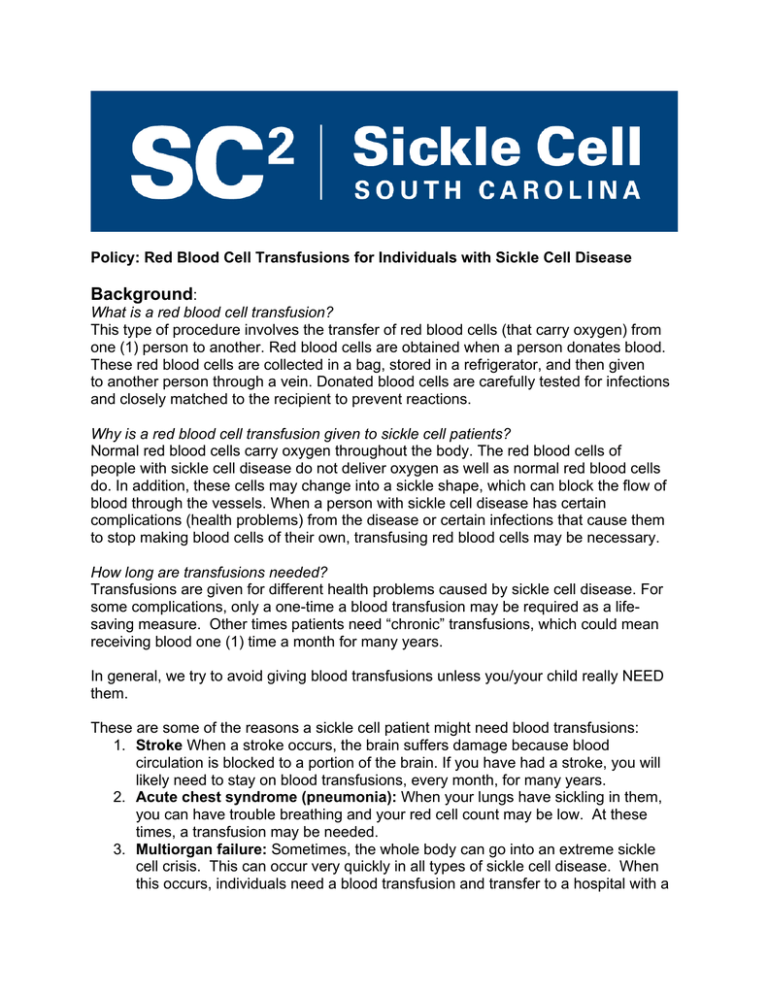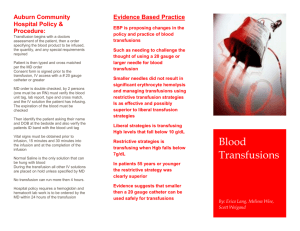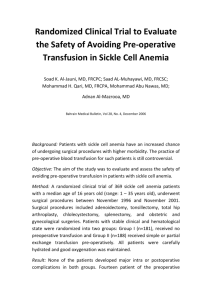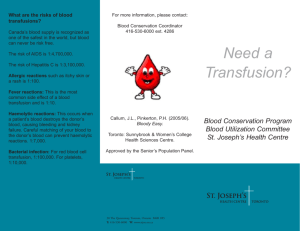Red Blood Cell Transfusions for Individuals with
advertisement

Policy: Red Blood Cell Transfusions for Individuals with Sickle Cell Disease Background: What is a red blood cell transfusion? This type of procedure involves the transfer of red blood cells (that carry oxygen) from one (1) person to another. Red blood cells are obtained when a person donates blood. These red blood cells are collected in a bag, stored in a refrigerator, and then given to another person through a vein. Donated blood cells are carefully tested for infections and closely matched to the recipient to prevent reactions. Why is a red blood cell transfusion given to sickle cell patients? Normal red blood cells carry oxygen throughout the body. The red blood cells of people with sickle cell disease do not deliver oxygen as well as normal red blood cells do. In addition, these cells may change into a sickle shape, which can block the flow of blood through the vessels. When a person with sickle cell disease has certain complications (health problems) from the disease or certain infections that cause them to stop making blood cells of their own, transfusing red blood cells may be necessary. How long are transfusions needed? Transfusions are given for different health problems caused by sickle cell disease. For some complications, only a one-time a blood transfusion may be required as a lifesaving measure. Other times patients need “chronic” transfusions, which could mean receiving blood one (1) time a month for many years. In general, we try to avoid giving blood transfusions unless you/your child really NEED them. These are some of the reasons a sickle cell patient might need blood transfusions: 1. Stroke When a stroke occurs, the brain suffers damage because blood circulation is blocked to a portion of the brain. If you have had a stroke, you will likely need to stay on blood transfusions, every month, for many years. 2. Acute chest syndrome (pneumonia): When your lungs have sickling in them, you can have trouble breathing and your red cell count may be low. At these times, a transfusion may be needed. 3. Multiorgan failure: Sometimes, the whole body can go into an extreme sickle cell crisis. This can occur very quickly in all types of sickle cell disease. When this occurs, individuals need a blood transfusion and transfer to a hospital with a sickle cell specialist. **In severe situations of stroke or acute chest syndrome, an exchange transfusion can be needed to replace the sickle blood with healthy blood using a machine and a special IV. • Abnormal transcranial Doppler ultrasound (TCD): TCD is a sound wave test that measures the blood flow in blood vessels of the brain. Very fast blood flow indicates that a child is at high risk for having a stroke. These children may need monthly blood transfusions for many years. What are the benefits of transfusion? Providing normal red blood cells in the circulation: • Allows more hemoglobin to better deliver oxygen to the body • Prevents blockage of flow in blood vessels • Decreases the need to produce new red blood cells, because transfused red blood cells live longer in the body than red blood cells in sickle cell disease. • Transfusions call also help prevent stroke or acute chest when given preventatively (as above) What are the possible risks of transfusion? • Iron overload: All red blood cells contain iron. When individuals get transfused blood, they get extra iron in their bodies. This excess iron from transfused red blood cells can build up and remain in the body (and get stuck in the heart, liver, and brain causing significant problems. Individuals often need to be treated with medicines to help remove iron from the body-called iron chelators. Examples: Exjade, Jadenu, Desferal, Ferriprox • Transfusion reactions There are many types of transfusion reactions that can occur. Thankfully, our medical technology allows us to match your blood to the donor blood to prevent the majority of these reactions. HOWEVER, IT IS IMPERATIVE THAT THE PRIMARY DOCTOR ALWAYS BE AWARE OF THE TRANSFUSION The body’s immune system may have a reaction to parts of the transfused blood. • Symptoms of an acute reaction (usually occurs during or immediately after the transfusion): rash, itching, chills, fever, and pain. • More serious reactions may cause shortness of breath. Other complications can develop over time: • Antibodies: The body’s immune system makes proteins called antibodies against the transfused blood cells. These antibodies may develop after only a few transfusions and make it harder to find matched blood. Sometimes the patient may have to stop receiving chronic transfusions and consider other types of medical treatment. This is why your doctor should always be aware if you are going to receive a blood transfusion. Delayed hemolytic transfusion reactions: • These reactions are very rare and usually occur 5-10 days after a blood transfusion. These reactions usually present with severe pain and yellowing of the eyes and darkening of the urine. There is often not an identifiable antibody which may confuse doctors not used to treating sickle cell disease. If you have had one of these reactions, you often CANNOT EVER GET ANOTHER TRANSFUSION. If this is occurring, you need to be transferred to a hospital with a sickle cell specialist. For a medical provider: when should you transfuse? It is very important that individuals with sickle cell disease ONLY get a blood transfusion when they really need it. These situations include: • Acute chest syndrome in which the individual is hypoxic. If the patient has a questionable infiltrate but does not have an oxygen requirement, appropriate pain and fluid management can usually help the patient (sometimes with antibiotics) without needing transfusions. • Respiratory failure: individuals with severe acute chest requiring several liters of oxygen, may need a full exchange transfusion. It is usually helpful to try a simple transfusion first but ensure that blood is available (or the patient is transferred) in case a higher level of care is needed. • Stroke/neurologic change: Individuals with SCD presenting with acute onset neurologic change (such as seizure, stroke, possible stroke), should undergo an immediate exchange transfusion. If the symptoms are obvious, it is NOT necessary to await the MRI. It is more important to do the transfusion and then the MRI. • Aplastic anemia: Certain medications (Bactrim, linezolid) and viruses (parvovirus as well as CMV, EBV and many others) can cause a temporary halt in red cell production. In these cases, individuals may need red cell transfusions to support their hemoglobin until the reticulocyte count recovers • Acute kidney or liver injury: In some cases, patients can present with significant acute kidney injury or liver injury. These cases should be co-managed with a hematologist. Patients may require red cell transfusions. • Preoperatively: Patients undergoing surgery need a transfusion (in most situations) to help prevent post-operative complications • Splenic or Hepatic Sequestration: These complications can occur in ALL ages and ALL genotypes of sickle cell disease. It used to be thought that only children could have splenic sequestration, however, many adults can suffer the same complication with severe outcomes if not treated quickly. When not to transfuse: • Simple vaso-occlusive crisis: while blood transfusions will help patients with sickle cell disease in pain (sometimes), transfusions should not be given for simple crisis. These individuals should continue to receive aggressive pain management and reduced rate IVF but should NOT get a transfusion unless they have a complication listed above. • • Any patient with a history of a delayed hemolytic transfusion reaction (DHTR) should NOT receive any red cell transfusions. EVER. These individuals should be managed by a hematologist if they become severely anemic. Mild anemia: Patients whose hemoglobin is 1-3g/dl below their baseline hemoglobin do not require a transfusion unless one of the other complications is also occurring. A reticulocyte count should always be checked to make sure patients are making new blood cells. As long as patients are producing red cells, transfusion for “low hemoglobin” alone is not indicated. Tips for successful transfusion practice in sickle cell patients: • When available, all individuals with sickle cell disease should have full red blood cell genotyping to better identify exactly what minor antigens are there/not there. Because many patients have a lifetime need for transfusions, it is important that we reduce the chance of allo-immunization. • If not available, all people with sickle cell disease should have a red blood cell phenotype done as an infant or toddler before they receive a transfusion. Although less effective than a genotype study, the phenotype study can also demonstrate most important antigen expressions. • All patients with sickle cell disease should undergo a thorough screen for antibodies prior to transfusions. As many individuals have a number of antibodies, this should be done at least 24 hours before a transfusion is needed if feasible. • Sickle cell patients without a known genotype or phenotype history and who have not been transfused in the past 3 months shall be phenotyped for C, E, and K. and the time of RBC screening. Phenotype-matched donor cells for these antigens shall be used to transfuse these non-alloimminized sickle cell patients. • If a genotype or phenotype is not able to be determined then transfuse only red cells negative for the C, E, and K antigens. • All units for Sickle Cell patients shall be Hgb S negative.






